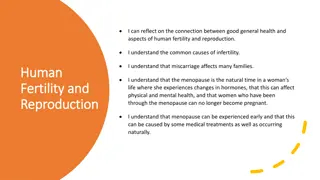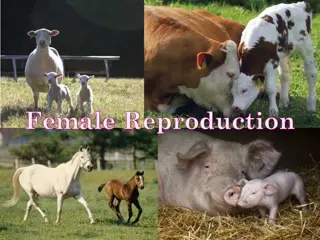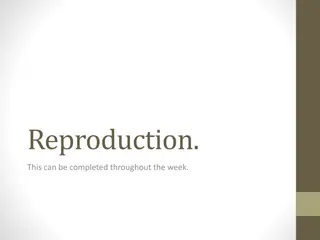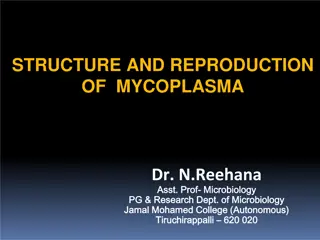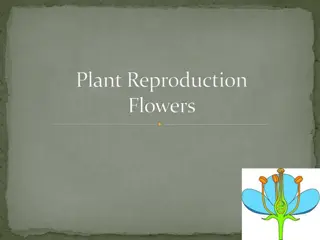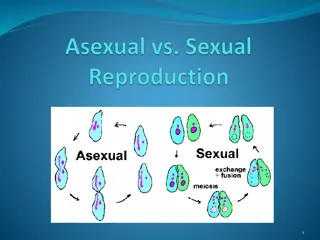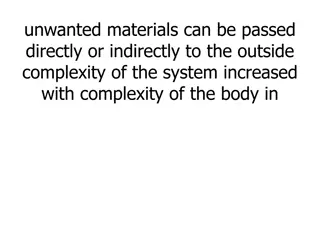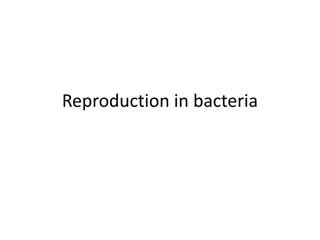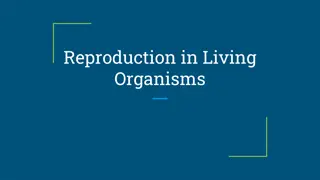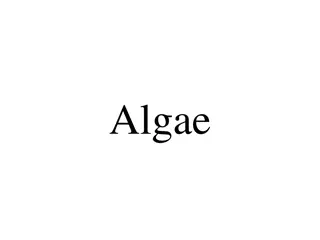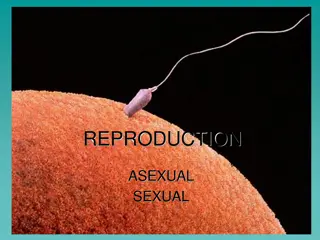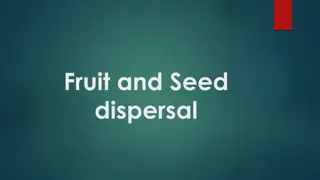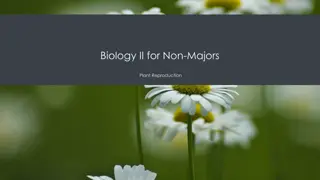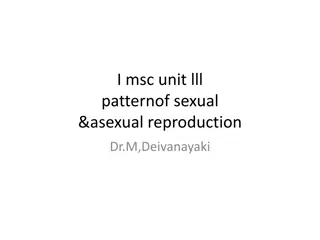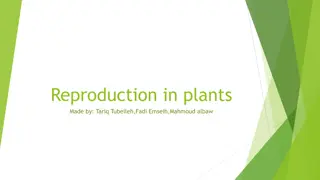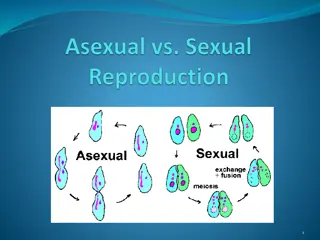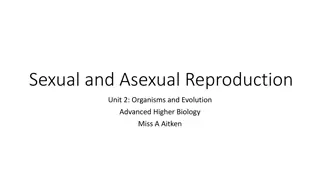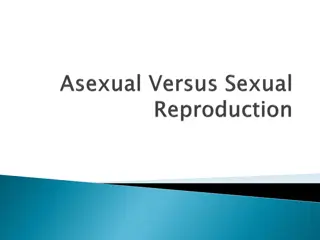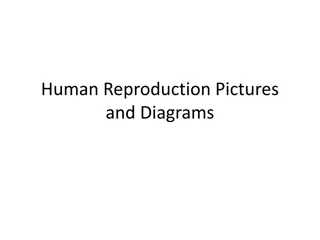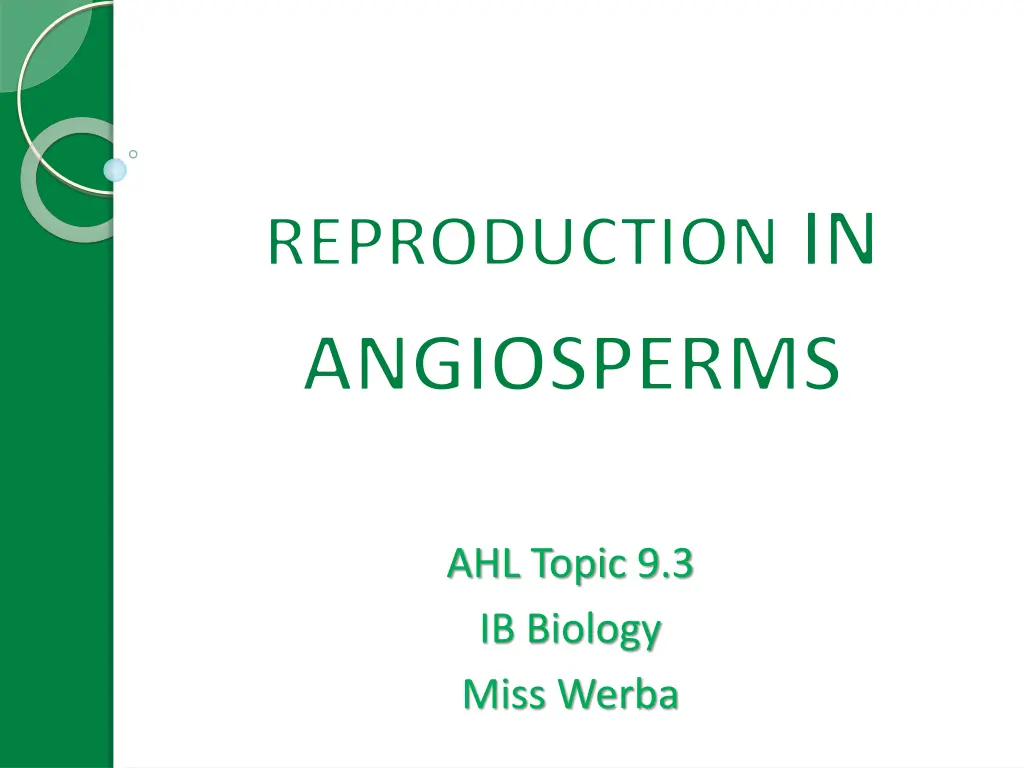
Angiosperm Reproduction Essentials
Explore the intricate process of reproduction in angiosperms, covering topics such as plant structure, pollination, fertilization, seed dispersal, and germination. Delve into the structure of animal-pollinated dicot flowers and the roles of reproductive organs within them. Gain insights into the crucial stages of pollination, fertilization, and seed dispersal for plant development.
Download Presentation

Please find below an Image/Link to download the presentation.
The content on the website is provided AS IS for your information and personal use only. It may not be sold, licensed, or shared on other websites without obtaining consent from the author. If you encounter any issues during the download, it is possible that the publisher has removed the file from their server.
You are allowed to download the files provided on this website for personal or commercial use, subject to the condition that they are used lawfully. All files are the property of their respective owners.
The content on the website is provided AS IS for your information and personal use only. It may not be sold, licensed, or shared on other websites without obtaining consent from the author.
E N D
Presentation Transcript
REPRODUCTION IN ANGIOSPERMS AHL Topic 9.3 IB Biology Miss Werba
TOPIC 9 PLANT SCIENCE 9.1 PLANT STRUCTURE and GROWTH 9.3 REPRODUCTION IN ANGIOSPERMS 9.2 TRANSPORT IN ANGIOSPERMS J WERBA IB BIOLOGY 2
THINGS TO COVER Structure of an animal-pollinated dicot flower Pollination Fertilisation Seed dispersal Structure of a dicot seed Germination: Metabolic events Favourable conditions Controlled flowering J WERBA IB BIOLOGY 3
ANIMAL POLLINATED DICOT FLOWER STRUCTURE Command term: DRAW and LABEL 9.3.1 J WERBA IB BIOLOGY 4
ANIMAL POLLINATED DICOT FLOWER STRUCTURE Command term: DRAW and LABEL 9.3.1 http://www.tokresource.org/tok_classes/biobiobio/biomenu/angiosperm_reproduction/index.htm J WERBA IB BIOLOGY 5
ANIMAL POLLINATED DICOT FLOWER STRUCTURE Command term: DRAW and LABEL 9.3.1 Reproductive organs of a plant are in the flower Flowers are often carry both male & female parts: Stamen = male organ, consisting of: a filament (stalk) an anther (pollen sacs) Carpel = female organ, consisting of: an ovary (containing ovules); a connecting style; a stigma (surface for receiving pollen) J WERBA IB BIOLOGY 6
DICOTYLEDONOUS ANIMAL POLLINATED FLOWER STRUCTURE Command term: DRAW and LABEL 9.3.1 Often have brightly coloured, modified leaves (petals) or a nectary to attract animals J WERBA IB BIOLOGY 7
POLLINATION , FERTILISATION & SEED DISPERSAL Command term: DISTINGUISH 9.3.2 Pollination: transfer of pollen from an anther to a stigma Fertilisation: fusion of male & female gametes to form a zygote Seed dispersal: carrying of the seed away from the vicinity of the parent plant to reduce competition J WERBA IB BIOLOGY 8
POLLINATION , FERTILISATION & SEED DISPERSAL Command term: DISTINGUISH 9.3.2 Pollination delivery of pollen from anther to stigma Fertilisation male and female gametes unite diploid zygote Seed dispersal wind water birds animals droppings depends on insects, birds, animals (angiosperms) zygote divides by mitosis & produces a new sporophyte after pollination, pollen tube goes down from pollen to ovary to fertilise the ovule J WERBA IB BIOLOGY 9
9.3.2 POLLINATION Command term: DISTINGUISH Self - pollination: pollen comes from anthers of the same flower or flowers of the same plant Cross-pollination: pollen comes from flowers on a different plant of the same species J WERBA IB BIOLOGY 10
9.3.2 FERTILISATION Command term: DISTINGUISH http://www.tokresource.org/tok_classes/biobiobio/biomenu/angiosperm_reproduction/index.htm J WERBA IB BIOLOGY 11
9.3.2 FERTILISATION Command term: DISTINGUISH Pollen grain germinates & produces a pollen tube Pollen tube grows down between cells of the style and then enters the ovule through the micropyle Two male nuclei are delivered: one nuclei fuses with the egg nucleus in the embryo sac, forming a diploid zygote other nuclei fuses with another nucleus & triggers the formation of the food store for the developing embryo Called double fertilisation J WERBA IB BIOLOGY 12
9.3.2 SEED FORMATION Command term: DISTINGUISH Seed: formed from a fertilised ovule, containing an embryonic plant and food store After fertilisation: zygote grows by mitosis to produce an embryonic plant (embryo root, embryo stem & 1-2 leaves) formation of stored food reserves is triggered & in many cases, is absorbed into the cotyledons As the seed matures, the outer layers of the ovule become the protective seed coat (testa) The whole ovary then develops into the fruit. J WERBA IB BIOLOGY 13
9.3.2 SEED DISPERSAL Command term: DISTINGUISH Seed dispersal: carrying of the seed away from the vicinity of the parent plant Enables the seeds to germinate further away from each other & reduce competition for resources (water, space, light, etc) Several plant structures have evolved to improve the likelihood of seed dispersal: eg. explosive mechanism to fling seeds into the wind eg. nice taste to attract animals J WERBA IB BIOLOGY 14
STRUCTURE OF A LIMA BEAN DICOTYLEDONOUS SEED Command term: DRAW and LABEL 9.3.3 J WERBA IB BIOLOGY 15
STRUCTURE OF A DICOTYLEDONOUS SEED Command term: DRAW and LABEL 9.3.3 http://www.tokresource.org/tok_classes/biobiobi o/biomenu/angiosperm_reproduction/index.htm J WERBA IB BIOLOGY 16
STRUCTURE OF A DICOTYLEDONOUS SEED Command term: DRAW and LABEL 9.3.3 Testa: protects the plant embryo and the cotyledon food stores Radicle: the embryonic root Cotyledons: contain food stores for the seed Micropyle: a hole in the testa (from pollen tube fertilisation) through which water can enter the seed prior to germination Scar: where the ovule was attached to the carpel wall J WERBA IB BIOLOGY 17
9.3.4 GERMINATION OF A SEED Command term: EXPLAIN Many seeds don t germinate as soon as they are formed & dispersed They have a dormant period This dormancy must be broken before germination can take place. J WERBA IB BIOLOGY 18
9.3.4 GERMINATION OF A SEED Command term: EXPLAIN Dormancy is overcome if the following conditions are met: water uptake has occurred to swell the seed & crack the seed coat oxygen is present for aerobic respiration to provide energy temperature is suitable for enzyme activity J WERBA IB BIOLOGY 19
9.3.5 GERMINATION OF A SEED Command term: EXPLAIN 1. Water absorption ruptures seed coat 2. Gibberellic acid (GA) produced triggers growth by acting on food storage cells 3. Hydrolytic enzymes (eg. amylase) convert stored starch to glucose & proteins to amino acids 4. Translocation taken to growing points of stem & root via phloem 5. Growth & development occur in stem & root 6. Seedling emerges J WERBA IB BIOLOGY 20
9.3.5 GERMINATION OF A SEED Command term: EXPLAIN http://bio1903.nicerweb.com/Locked/media/ch38/38_10SeedGermination-dicot.jpg http://bio1903.nicerweb.com/Locked/media/ch38/38_10SeedGermination-dicot.jpg J WERBA IB BIOLOGY 21
9.3.5 GERMINATION OF A SEED Command term: EXPLAIN External Internal Water uptake hydration of cytoplasm of cells of embryo Ambient temperature within optimum range for enzyme action period of low T followed by higher T ensures seed germinates after winter has passed Overcoming dormancy Production of gibberellic acid: GA produced by embryo cells to initiate biochemical changes of germination leads to production of hydrolytic enzymes for mobilisation of stored food Oxygen to sustain aerobic cell respiration Light: ensures photosynthesis is possible J WERBA IB BIOLOGY 22
9.3.6 PHOTOPERIODISM Command term: EXPLAIN Photoperiodism: an organism s response changes in day length At high latitudes this is important because the change in length of the day indicates the season Days getting shorter indicate winter is approaching Days getting longer indicate summer is approaching Some plants regulate their flowering this way J WERBA IB BIOLOGY 23
9.3.6 PHOTOPERIODISM Command term: EXPLAIN Change in day length Photoperiod mechanism in the leaves Florigen hormone Flower buds Flowering J WERBA IB BIOLOGY 24
9.3.6 PHOTOPERIODISM Command term: EXPLAIN Long-day plants: have a maximum number of hours of darkness if they are to produce flowers will flower during summer, when the days are longer eg. carnations, clover Short-day plants ( long-night plants) need a minimum number of hours of darkness before they can flower will flower during spring & autumn when the days are shorter eg. coffee, strawberry J WERBA IB BIOLOGY 25
9.3.6 PHOTOPERIODISM Command term: EXPLAIN Many plants use phytochrome to regulate their photoperiodism. Phytochrome is a photoreceptor. It exists in 2 versions which are inter-convertible: PR absorbs red light (660nm) PFR absorbs far-red light (730nm) RED LIGHT (sunlight) PR PFR FAR RED LIGHT J WERBA IB BIOLOGY 26
9.3.6 PHOTOPERIODISM Command term: EXPLAIN PR is the inactive form When PR absorbs red light is converted into active form of PFR After PFR absorbs far red light rapidly converted back into PR PFRalso turns intoPRin the dark! RED LIGHT (sunlight) PR PFR FAR RED LIGHT J WERBA IB BIOLOGY 27
9.3.6 PHOTOPERIODISM Command term: EXPLAIN Daylight contains a lot of red light So after many hours of daylight, plants will have most of their phytochrome as PFR After a night of uninterrupted darkness, most of the phytochrome will be back to PR As the conversion from PFR to PR is very quick even a flash of light during the night can disrupt the process! J WERBA IB BIOLOGY 28
9.3.6 PHOTOPERIODISM Command term: EXPLAIN J WERBA IB BIOLOGY 29
9.3.6 PHOTOPERIODISM Command term: EXPLAIN Plants are sensitive to the amount of PFR In long-day plants, PFRis required for flowering. In short-day plants, PFRinhibits the formation of flowers. J WERBA IB BIOLOGY 30
Explain the conditions that are needed to allow a seed to germinate. [5 marks] water needed to rehydrate the seed; gibberellin released / active after water absorbed; gibberellin needed to produce amylase; water needed to allow substances inside the seedling to be transported; oxygen needed for (aerobic) cell respiration; warmth needed to speed up metabolism/enzyme activity; warmth indicates that it is a favourable season for germination/spring; some seeds need a cold period to stimulate germination; some seeds need fire to stimulate germination; some seeds need to pass through an animal (gut) to stimulate germination; 31
Explain how flowering is controlled in long-day and short- day plants. [7 marks] flowering is affected by light; phytochrome; phytochrome exists in two forms/Pfr and Pr; Pr (red absorbing/660 nm) converted to Pfr (far-red/730 nm absorbing) in red or day light; sunlight contains more red than far red-light so Pfr predominates during the day; gradual reversion of Pfr to Pr occurs in darkness; Pfr is active form / Pr is inactive form; in long-day plants, flowering induced by dark periods shorter than a critical length / occurs when day is longer than a critical length; enough Pfr remains in long-day plants at end of short nights to stimulate flowering; Pfr acts as promoter of flowering in long-day plants; short-day plants induced to flower by dark periods longer than a critical length/days shorter than a critical value; at end of long nights enough Pfr has been converted to Pr to allow flowering to occur; Pfr acts as inhibitor of flowering in short-day plants; 32

